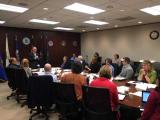News Releases from Headquarters›Water (OW)
Administrator Pruitt Takes Important Action on Lead-Contaminated Site, Announces WIFIA Program in Indiana
WASHINGTON — Today, U.S. Environmental Protection Agency (EPA) Administrator Scott Pruitt signed a memorandum to accelerate removal of lead contamination in Indiana, near the site of a former metals facility. He also announced that Indiana will receive a $436 million federal loan through the Water Infrastructure Finance and Innovation Act (WIFIA) program.
"EPA is working closely with the State of Indiana in its effort to quickly remove dangerous lead contamination and repair vital water infrastructure," said EPA Administrator Scott Pruitt. "This visit advances our partnership with the state to clean up contaminated lands and ensure all Hoosiers have clean and safe water."
Administrator Pruitt first visited a lead-contaminated property in Whiting, Indiana, near the site of the former Federated Metals Corporation facility. Following the visit, he met with Mayor Joseph Stahura (Whiting), EPA Regional Administrator Cathy Stepp, and Governor Holcomb, and signed a memorandum to conduct a time-critical removal action on the lead-contaminated soil from the properties. This action authorizes $1.7 million to address lead contamination in soil that could affect citizens in those communities.
Administrator Pruitt joined Governor Holcomb for a roundtable with local stakeholders and commended the state for the creativity in its application for a FY2017 WIFIA loan and noted the project as an example for other states to follow. Once all needed processes are completed, the state will receive a $436 million loan to provide revolving loans to local water entities to focus on drinking water and wastewater treatment projects.
“Today’s visit is more evidence of the EPA’s ongoing commitment working with state and local officials to improve conditions for Hoosiers,” said Governor Eric Holcomb. “For the northwest region, the agreement we signed today lets us get a head start on rehabilitating contaminated areas in Whiting and Hammond. And, we’ll put $436 million in new federal funds to good use in communities around the state to improve aging water infrastructure.”
Administrator Pruitt finished his trip with a visit to the EPA Region 5 office in Chicago, Ill. where he met with EPA Regional Administrator Stepp and the hardworking staff to get an update on important issues and improvements taking place in Region 5.
Background:
The WIFIA program received $63 million in funding in the Consolidated Appropriations Act, 2018, which was signed into law by President Donald Trump on March 23, 2018. This more than doubles the program’s funding from 2017. Leveraging private capital and other federal and state funding sources, projects funded through WIFIA loans could support up to $11 billion in water infrastructure investment and create more than 170,000 jobs. This year’s Notice of Funding Availability (NOFA) highlights the importance of protecting public health, including reducing exposure to lead and other contaminants in drinking water systems and updating the nation’s aging infrastructure.
Established by the Water Infrastructure Finance and Innovation Act of 2014, the WIFIA program is a federal loan and guarantee program at EPA that aims to accelerate investment in the nation’s water infrastructure by providing long-term, low-cost supplemental loans for regionally and nationally significant projects.
WIFIA credit assistance can be used for a wide range of projects, including:
- Drinking water treatment and distribution projects;
- Wastewater conveyance and treatment projects;
- Enhanced energy efficiency projects at drinking water and wastewater facilities;
- Desalination, aquifer recharge, alternative water supply, and water recycling project; and
- Drought prevention, reduction, or mitigation projects.
For more information about WIFIA and this funding announcement, visit: https://www.epa.gov/wifia



